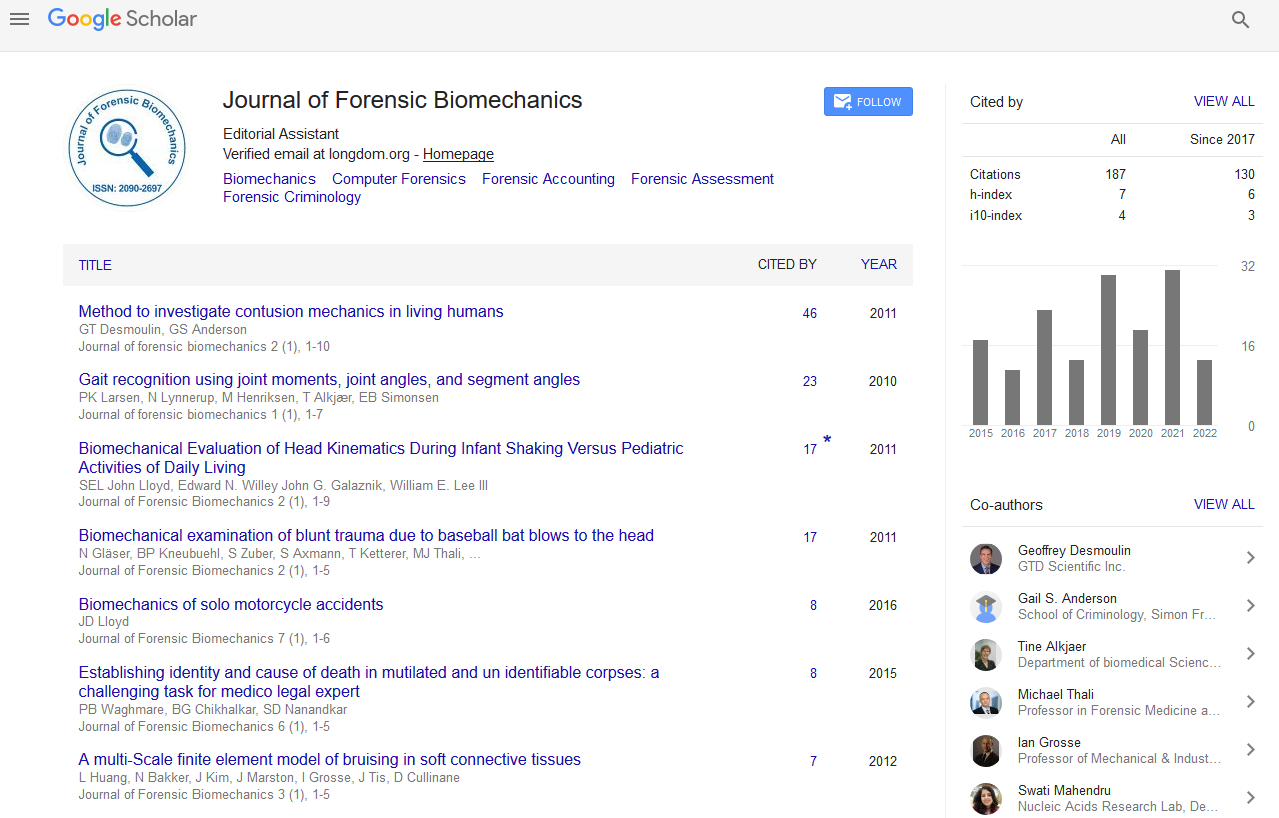Indexed In
- Genamics JournalSeek
- SafetyLit
- Ulrich's Periodicals Directory
- RefSeek
- Hamdard University
- EBSCO A-Z
- Geneva Foundation for Medical Education and Research
- Euro Pub
- Google Scholar
Useful Links
Share This Page
Journal Flyer

Open Access Journals
- Agri and Aquaculture
- Biochemistry
- Bioinformatics & Systems Biology
- Business & Management
- Chemistry
- Clinical Sciences
- Engineering
- Food & Nutrition
- General Science
- Genetics & Molecular Biology
- Immunology & Microbiology
- Medical Sciences
- Neuroscience & Psychology
- Nursing & Health Care
- Pharmaceutical Sciences
Commentary - (2024) Volume 15, Issue 1
Biomechanics and Forensics Combined in Body Dynamics
Sheng Pan*Received: 01-Mar-2024, Manuscript No. JFB-24-25415 ; Editor assigned: 04-Mar-2024, Pre QC No. JFB-24-25415 (PQ); Reviewed: 18-Mar-2024, QC No. JFB-24-25415 ; Revised: 25-Mar-2024, Manuscript No. JFB-24-25415 (R); Published: 01-Apr-2024, DOI: 10.35248/2090-2697.24.15.475
Description
In the elaborate creation of forensic science, every quantity of evidence clamps a division in the making to be disclosed. One area that has gained significant attention in recent years is the intersection of biomechanics and forensics, where the dynamics of the human body become a important tool in solving crimes. By understanding how the body moves and responds to various forces, forensic experts can reconstruct events, determine causes of injury, and provide invaluable visions into criminal investigations. This synthesis of biomechanics and forensics not only aids in recognition the truth but also enhances our understanding of mortal physiology and mechanics.
Biomechanics
At its core, biomechanics is the study of the mechanical aspects of living organisms, particularly the human body. It delves into how bones, muscles, tendons, and ligaments interact to produce movement and maintain stability. This interdisciplinary field draws upon principles from physics, engineering, anatomy, and physiology to analyze and understand the complexities of human motion. In forensic science, biomechanics plays a key role in reconstructing events leading to injuries or fatalities. By applying principles of physics and mechanics, experts can determine the forces involved in traumatic incidents such as falls, collisions, or assaults. These analyses often involve examining injury patterns, evaluating the properties of materials involved, and simulating scenarios to establish causality.
Understanding bodily dynamics in forensics
The application of biomechanical principles in forensics extends beyond injury analysis. It encompasses a broad spectrum of investigations, including accident reconstruction, gait analysis, and even the interpretation of bloodstain patterns. By comprehensively analyzing the dynamics of the human body, forensic experts can provide Essential insights into various aspects of criminal investigations:
Accident reconstruction: Biomechanical analysis is instrumental in reconstructing accidents involving vehicles, falls, or other traumatic events. By considering factors such as speed, impact angle, and the biomechanical properties of tissues, experts can simulate the sequence of events leading to an accident and determine its cause with a high degree of accuracy.
Gait analysis: The unique characteristics of an individual's gait can serve as valuable forensic evidence. Biomechanical analysis of gait patterns can help identify suspects in surveillance footage or establish the presence of an individual at a crime scene. By examining parameters such as stride length, cadence, and joint angles, experts can distinguish subtle differences in gait patterns and draw conclusions regarding the identity or movement of individuals involved in criminal activities.
Injury assessment: Biomechanics aids in understanding the mechanisms of injury, allowing forensic experts to differentiate between accidental and intentional injuries. By analyzing the forces required to cause specific injuries and correlating them with the circumstances of the incident, experts can provide valuable insights into the dynamics of traumatic events. This information is Essential in determining liability, assessing the credibility of witness statements, and ensuring justice is served.
Challenges and advancement: Despite its potential, the integration of biomechanics into forensic science poses several challenges. Foremost among these is the variability inherent in human anatomy and physiology. Individuals exhibit unique biomechanical characteristics influenced by factors such as age, gender, body composition, and underlying medical conditions. Accounting for this variability requires sophisticated modeling techniques and a comprehensive understanding of human biomechanics. Advancements in technology have significantly enhanced the capabilities of biomechanical analysis in forensics. High-speed cameras, motion capture systems, and computational modeling tools allow for more accurate and detailed reconstructions of events.
Furthermore, advances in medical imaging techniques such as CT scans and MRI enable forensic experts to visualize internal injuries and assess their biomechanical implications with greater precision. Moreover, interdisciplinary collaborations between biomechanics, forensic scientists, engineers, and medical professionals have facilitated the development of standardized protocols and methodologies for biomechanical analysis in forensic investigations. These collaborative efforts have not only improved the reliability and validity of forensic findings but have also fostered innovation and knowledge exchange across disciplines.
Conclusion
The convergence of biomechanics and forensics represents a significant advancement in the field of forensic science. By leveraging our understanding of human biomechanics, forensic experts can find the key hidden within the dynamics of the human body. Whether reconstructing accidents, analyzing gait patterns, or assessing injury mechanisms, the application of biomechanical principles provides invaluable insights into criminal investigations.
Citation: Pan S (2024) Biomechanics and Forensics Combined in Body Dynamics. J Forensic Biomech. 15:475.
Copyright: © 2024 Pan S. This is an open-access article distributed under the terms of the Creative Commons Attribution License, which permits unrestricted use, distribution, and reproduction in any medium, provided the original author and source are credited.

